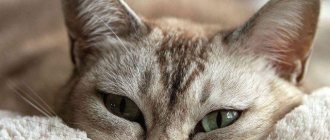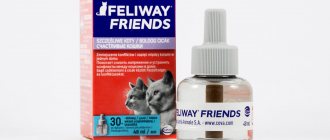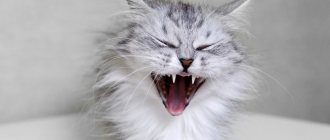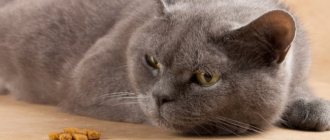When a kitten appears in the house, it becomes a joy for the whole family. But at the same time, few people think about what actions should be taken to ensure that the cat is sociable and affectionate. It is believed that a cat should be like this by default.
For a cat to grow up friendly and affectionate, care and love alone are not enough.
It is no easier to develop the desired character in a cat than in a child. Since a cat does not have the same verbal communication abilities as humans, does not experience feelings of guilt and acts based on previous experience and natural instincts, its upbringing can be quite difficult.
Often, breeders are faced with the fact that male cats do not want to get closer to their owner.
It is extremely important to understand the psychology of this animal and realize that the biggest problem is lost time. And if a cat is already five years old, and she demonstrates the inclinations of a small tyrannosaurus, then you should not expect that she will turn into an affectionate flower in six months: cats are simply characterized by incredible conservatism and stubbornness.
However, with appropriate efforts, you can make even very aggressive and wayward cats trusting and affectionate. By the way, if there is no trust between the owners and the cat, then you can’t count on any results at all.
Love is a feeling, and feeling must be cultivated in an animal.
A cat, being constantly alert, simply cannot relax, and without relaxation, it will never be able to show love and affection. So, to make your cat affectionate, you should familiarize yourself with seven secrets.
Who is the head in this house
All people understand that they are stronger, smarter and bigger, but often the reason for restraint on the part of a cat is the awareness of the same thing. And if the owner demonstrates that he is in charge at every opportunity, then you should not be surprised that the cat will feel uncomfortable.
Let the cat at least sometimes feel like a mistress.
Do not forget that cats living in natural conditions are loners, and if they feel that they are being subjugated, they simply leave their territory to where they will be the absolute masters. A domestic cat cannot do this, so it only experiences aggression and stress. There is no need to confuse dogs and cats. Under no circumstances should dogs be placed on the same level as you, but a cat will be more affectionate the more self-confident she feels.
To make a cat become affectionate, you should try hard.
Therefore, it is better to be careful with manifestations of your superiority and various punishments: an increasingly frightened cat is almost unable to perceive information. However, you shouldn’t spoil your pet either. You should not confuse an affectionate cat with an insolent one. It is quite enough to simply control yourself and not stoop to shouting, coercion and punishment.
By being patient and having free time, you can make even the most inert cat affectionate and trusting.
The main weapon should be cunning and persuasion. If a cat has done something wrong, you can pretend to be a big cat and hiss, but if she has done something right, she must be praised.
Why did the cat suddenly become affectionate? What to do if your cat is too affectionate to the point of intrusiveness
Oddly enough, I often hear stories that owners return cats to shelters because they turned out to be too affectionate.
It would seem like a dream to sit by the fireplace on a cold winter evening and hold a warm fluffy cat curled up on your lap. But cats are capricious creatures and want to be close to their owner not only in the evenings by the fireplace, but also during the day, while working at the computer, during lunch, while taking a bath, and even at night they try to mount the owner on his head. But people are all different, there are those for whom personal space is important, who love peace and solitude and do not like hugs. A Velcro cat will create a lot of anxiety and inconvenience for such comrades. Causes of excessive intrusiveness in a cat:
Kira is only affectionate with her cat Tisha. This makes her different from most orientals. But I'm completely fine with it.
If you are one of those people who does not celebrate hug day, then you should carefully consider the selection of your pet. After all, the extreme affection of cats is often due to their breed or innate character and cannot be eliminated. Therefore, choose cats that are not very friendly breeds.
Who should NOT be adopted if you don’t want to spend the whole day petting and hugging: Siamese, Thai, Oriental, Sphynx, Rex and other descendants of Oriental cats. Who can have: British cat, Scottish cat, Siberian cat, Persian cat, etc. Long-haired breeds are often less likely to cuddle than short-haired breeds.
If you are adopting a cat from a shelter or foster home, ask the volunteers about its character. Keep in mind that behavior in a shelter may be completely different from behavior in a home environment, so always agree on a trial period for the animal during which it can be returned. Although, of course, it’s better if you choose, then once and for all.
Adaptation (the period of defrosting after shelter) also greatly affects the character of the animal. The fact that a cat is very affectionate in the first few months after adoption may change over time. Adaptation mechanisms work in such a way that a cat, getting used to an unusual environment, can show certain qualities that are not characteristic of it in ordinary life, and when the adaptation is over, it can become a “different person.” That is, an affectionate cat can become somewhat aloof, while a timid and aloof cat can become a velcro cat over time.
Boredom makes a cat follow its owner everywhere and ask for attention! If a cat has nothing to do during the day, is not played with according to a routine, does not have interactive toys and the opportunity to watch birds on the street, then its only activity during the day will be communication with its owner. Such cats often follow the owner from room to room, meow a lot, demanding attention, suck the owner’s things or body parts, and try to block the owner’s field of vision when he is sitting at the computer, standing between him and the screen. If you decide to get a cat, then no matter how you look at it, you will have to spend time on it. Even the most aloof British cat needs physical and emotional activity.
The most affectionate cat that ever lived with me is Stepashka.
Regular displays of affection
We should not forget that a cat is a living creature with its own personality traits. Rarely is an animal so patient as to wait until the owner has free time to communicate with his pet.
Cats and cats are very freedom-loving.
Only those cats that have been treated kindly by their owners are affectionate. Therefore, take time for hugs, conversations with her, relaxation together, and other things. And, if there is a lot of work, try to set aside at least ten minutes for joint caresses, and the rest of the world will wait a little longer. Remember that even a once affectionate animal, if no one communicates with it, can go wild.
You can’t get a kitten when you have little time left to communicate with it.
However, you shouldn’t impose yourself either. The cat may also be in an inappropriate mood. Therefore, if the cat is in the mood for privacy, just pet it behind the ear when you pass by, and do not insist. If she purrs in response, it means she is ready to communicate. And if not, then you should wait for a more favorable moment.
If the cat realizes that it is not in charge, it leaves the territory.
Unfortunately, among the owners, along with the inattentive, there are also those who constantly cuddle and carry their pet in their arms, and then wonder why he is not inclined to contact.
What is the normal level of affection in cats?
Some cats like to show their owners love. Others prefer not to show affection. They fear it will weaken their claims to dominance or territory.
If your cat never comes close to you, that's bad; it may be afraid of you. Your cat will live in constant worry. As Veterinary Clinics of North America explains, this can lead to health and behavioral problems.
However, a cat refusing to leave you is also problematic. This can be physically dangerous as cats may get underfoot. Your cat may also develop separation anxiety. This will result in your cat damaging your home in some way when you leave the house.
A normal, happy cat will not be clingy or indifferent. The cat will seek attention when it wants it. Most often these will be:
- First thing I do in the morning
- When you return home from work
- When is the scheduled game time?
If your cat is affectionate during this time, you have a healthy relationship. Everything that more or less needs to be controlled.
Is a cat tame?
Very often, breeders are asked to show how to properly pick up a cat or kitten. And they are very surprised when the breeder asks why the cat is carried in his arms at all. Here we should again turn to wild feline relatives, for whom restriction in movement is an unambiguous sign of danger. For many apartment dwellers, such a limitation can be the position on their hands.
The difference between cats and dogs is that a dog will do everything for its owners to be loved, and a cat will do everything for its owner if he already loves it.
Therefore, if you really want to lisp with a kitten, just sit him on your lap and, without forcing him to do anything, caress him as much as you want. The kitten's claws should be trimmed in the same way. And if you suddenly decide to put the kitten in the bath, you need to take it with your hand under the chest and stroke its back with your free hand. And in this position the kitten should be raised. A cat will only trust its owner when it feels that it can leave at any moment.
Affectionate cat. 30 of the cutest and most affectionate cat breeds
Future owners, when choosing a kitten, make certain demands on the new resident. Some people want to have an active and restless friend, while others want an affectionate kitten.
This point is especially important in families with children. The cutest cat breeds bring joy, pleasure and love into the lives of their owners, and also help create a cozy environment in their home.
Shorthair exotic
A cat with a childish appearance is very popular all over the world. She has no aggression at all. Exotic has a very playful character, loyalty and friendliness.
The cat can stay next to the owner around the clock, follow on his heels and loves to sit in his arms. The calm and affectionate exotic loves to play with children and is very kind to them.
Nibelung
Representatives of the Nibelung breed quickly become attached to a person and choose one owner for life. Despite this, they are affectionate and sweet with other family members. They love to play with children, but treat them patronizingly. Fluffies are undemanding and do not know how to take offense at all. They do not tolerate quarrels, shouting and scandals.
Ragdoll
The fluffy ragdoll is an unusual breed that has low muscle tone and a pain threshold. Lying in your arms, the animal completely relaxes and turns into a rag doll.
Ragdolls are strongly attached to their family. They sleep, eat and do household chores with them. They cannot be denied communication. Fluffy rag dolls are quite affectionate and suffer from inattention.
The hunting instinct and aggression are absent. Therefore, it is important to ensure that cats of this breed do not end up on the street.
Himalayan
Himalayans have an affectionate, inquisitive, kind and intelligent disposition. They love attention, but at the same time they understand that the owner is at work and the separation is forced.
Fluffies get along well with children, never offend them and love to be in contact with them. They gladly accept human care and tactile contact.
The animal is unobtrusive and moderately active, which is why older people adore this breed.
Burmese cat
Despite the visual inaccessibility, majestic grace and charisma, it is very easy to earn the love of this fluffy beauty. The animal's devotion and cheerfulness are amazing. Cats of this breed love to spend time with a person, giving him tenderness in response to care.
The cat loves close physical contact, so it sleeps only next to its owner. Between sleeping and spending time with her owner, she will always choose the latter. Burma loves to “talk” while looking into the eyes. Her gentle purring will calm the nervous system even on the most stressful day.
Peterbald
A type of sphinx that is more similar in personality to a dog than a cat. Insanely loyal, smart and talkative cats.
They don’t leave their owner’s side, and after separation they happily jump up and down, almost wagging their tail. They treat children well and play with them with pleasure. They love to eat delicious food and are very clean.
Oriental
Graceful and sophisticated Orientals never show aggression towards humans. They are not prone to anger, they are always sweet, friendly and full of friendliness. These cats are talkative, love noisy games with children and are extremely energetic.
It is difficult for them to sit still, so you should not be surprised if you see a pet on a closet or chest of drawers. A broken flower pot is a common story.
York chocolate
This breed always behaves kindly and reservedly. She easily adapts to the rhythm of life of her owners, thanks to her learning ability and tact. The cat does not show aggression, so it is suitable for families with children.
The Yorkie always enjoys the company of people; it needs constant attention and tactile contact. At the same time, they are completely unobtrusive. The cute creature can silently follow its owner all day long, waiting for affection and entertainment.
Burmilla
The fluffy beauties of this breed are quite light and easy to communicate with. One should not expect aggression from them. Attentiveness, tenderness, kindness and intelligence are the main character traits of Burmillas.
The cat is suitable for large families, as it loves chatty owners and a large number of people. Burmilla needs human contact, entertainment and games. If she is not given attention for a long time, the sly one will begin to purr persistently.
Poodlecat
A rare breed that was created by crossing six breeds of cats.
Poodlecats are sociable and affectionate. They adore their owner and are ready to spend all their time with him instead of eating and sleeping.
They are unobtrusive, have no aggression and are very loyal cuties. They have incredible sensitivity. If they need to be close, they will purr affectionately in their owner's ear. At the same time, they feel the moment when they need to leave the person alone. The pet loves to play with children and can chase them around the apartment for hours.
Height
For an animal to be sociable and trusting, it must feel completely safe. What will a cat do if it suddenly feels threatened? Most likely, he will run away and climb a tree. Under natural conditions, a cat that has climbed to a height has almost no one to fear. Therefore, you should make sure that your cat has plenty of high places to hide.
Cats do not know how to obey; they are loners by nature.
The cat became affectionate with age. Their behavior is easy to predict
It’s hard to tell from a small kitten whether he will settle down with age or will continue to have a “tygydyk” every night. But with adult cats, everything is clear: over the years of living together, the owner and the pet have perfectly studied each other’s characters. You know what food and treats he prefers and what toys he likes, and you can also easily understand whether the pet is now in the mood for communication or wants to sit on the windowsill alone.
Cats also know a lot about you. For example, over time they get used to their owners’ schedule and understand what time they will be fed and what time they will play with them. And even if the owners have to stay late at work, the cat is unlikely to make a mess at home in retaliation. To ensure that the cat does not worry unnecessarily, if possible, protect him from unnecessary worries - a sudden change in diet or a sudden move can be stressful for the pet, and in the case of older cats, it is better to avoid this Cat Nutrition Tips.
Lilia Rzhavskaya
Mars Petcare science communication expert and veterinarian.
In order to understand whether a cat is stressed, it is worth looking at the situation through its eyes. Stress is a state of increased tension in the body, which occurs as a defensive reaction to various unfavorable factors. The reasons can be very different: the arrival of a new family member (for example, a baby), another pet, moving. Cats can also react to things that are less significant from a human point of view, such as the frequent presence of noisy guests at home, renovations, or simply rearranging furniture. Even the absence of an old chair can be a tragedy for a pet.
Therefore, the owner needs to be attentive to his pet and monitor his mood no less closely than his health. Stress may include symptoms such as loss of appetite, constant licking, litter box refusal, hiding, or aggression. You need to minimize your exposure to stressful situations. It is better for the pet to remain in its familiar environment, where it will feel safe. A cat is a hunter by nature, so try to play with it whenever possible. And when several pets live at home, the level of competition between them can be reduced by placing additional trays or placing bowls with food in different planes of the room.
There are other ways to help reduce stress if the measures listed above are unsuccessful. For example, you can purchase pheromones for cats - when sprayed into the environment, they work as a calming agent for your pet. And if your cat still experiences tension, you should consult a veterinarian.
Maine Coon
There are 2 legends of the origin of this breed. The first says that the Maine Coon was created by crossing a cat and a female raccoon. The second is a North American lynx and a cat. Connoisseurs of this cat breed claim that the breed arose through evolution.
The Maine Coon is one of the largest breeds of cats. The length of the cat with tail reaches up to 120 cm. Individuals of this breed are very hardy.
They are also called cat dogs for their friendliness and intelligence. Maine Coons can be trained if desired. Despite their size, Maine Coons are very gentle animals and will find a common language with any member of your family. They cannot stand loneliness. Maine Coons love to play, jump and run, so they need a lot of attention.
The average lifespan of this breed is about 12.5 years. With such an impressive lifespan, these cats are susceptible to some diseases. The most common is heart disease.
The Maine Coon's diet should be natural and consist of meat and vegetables.
They can also be trained to go for walks. This must be done from childhood, carrying the kitten in your arms for 5 minutes. Over time, increase your walking time.
At what age should you adopt a kitten to make it easier to raise it?
Breeders recommend adopting kittens at the age of 3 months. By this time, the baby becomes independent and it is easier for him to part with his mother. A kitten that has not experienced severe stress from a change of home will be more contactable with humans. A raised animal has a lot of advantages over a baby :
- the kitten is already socialized and ready to learn;
- the animal is accustomed to the tray and scratching post;
- some of the cats have already been neutered, so they are more affectionate towards their owner;
- the animal knows the rules of behavior in the house.
© shutterstock
It will be easier to raise a grown cat than a 1-2 month old baby. The animal is already socialized, so the learning process will not be difficult. When choosing a pet in a breeder's home, give preference to friendly, affectionate kittens who will make contact themselves.
Language of the body
The position of an animal's body and movements can tell a lot about its mood and condition.
Tail.
Waving or twitching indicates nervous tension. The animal is clearly dissatisfied or angry with something and is ready to move to active defense. It's better to leave him alone. A pipe tail is a sign of satisfaction and good mood. Most likely, the cat will be happy to communicate and will willingly play with you. A frightened pet hides its tail between its paws. Also, a tucked tail can be an indicator that the animal is in pain. If the tail remains tucked for a long time, and there is no reason to be afraid, contact your veterinarian immediately.
Back.
An arched back, raised fur and flattened ears are a sign of detected danger. Your pet is trying to get bigger in order to intimidate its intended opponent. At such a moment, he is ready to defend himself; you should not try to pick him up or stroke him. Just wait until he calms down. But the pet turned over on its back is relaxed and completely trusts you. Animals love to ride on their backs. This way they relax and relieve stress.
Ears
very mobile. Changing their position is not only an orientation to the sound source. Straight ears are a sign of a calm, “neutral” mood. Pressed to the head indicates that the animal is very angry or scared. Back-facing is an indicator of excitement or interest. At such a moment, your pet is ready to play or is interested in what is happening around him.
Plunge crawling
- a manifestation of the hunting instinct. The predator hides in ambush for a long time, tracking down its prey. He presses his stomach to the floor, lowers his ears to become as inconspicuous as possible. Often this behavior is followed by a lightning-fast jump and capture of the hunted object. If a cat moves this way for no apparent reason, it is most likely frightened by something.
If a cat crouches to the floor for no apparent reason, something has frightened it. Try to eliminate the source of anxiety, talk to your pet to calm him down.
The cat is rubbing.
There are scent glands on the face and paws, with the help of which the animal leaves marks to mark its territory. This way it feels more confident, and its relatives understand: the place is occupied. Your pet “butts” you with his head and rubs his sides - he expresses a special affection, marks you as his own.
Gaze
when sitting motionless next to a person or object - a request for help. The cat is waiting for you to open the door or window for it, fill the bowl with food, or take out the rolled toy. Or you sleep too long, and your pet is bored and waiting for attention.
Kitten scratching
The process of raising a kitten involves correcting unwanted behavior. How to make a kitten be affectionate and not scratch in games? There are several techniques :
- If the baby gets playful and starts scratching, then spray him with water from a spray bottle.
- After the bite, begin to ignore the baby. You can be in the same room with him, but not pay attention to him, so he will understand that his behavior is unacceptable.
- You can trim the animal's claws. For the first time, it is better to carry out this procedure in a veterinary clinic.
- You can train a cat using special silicone caps for claws; with them, he will not be able to cause injuries.
The baby will grow up, but if he is not weaned from scratching in childhood, then this habit will continue with age. Therefore, you need to think about how to raise a cat even before purchasing an animal. An affectionate pet will purr on its knees and not release its claws.
© shutterstock
The cat has become an affectionate sign. Signs about the behavior of cats and kittens
Many people are skeptical about signs, while others firmly believe that a cat’s behavior can tell about the near future and be a harbinger of unexpected events.
It is not known who is right, so everyone decides for themselves whether to believe in omens about cats or not.
If he sneezes
Many signs are associated with sneezing in cats:
- If a cat sneezes, the sign says that the person will have toothache. It is necessary to tell the cat: “Be healthy!” to smooth out the negative impact.
- If a cat sneezes next to lovers, then they will soon get married.
- In England they believe that if a cat sneezes, it will rain. And if a cat sneezes three times in a row, then someone in the house may catch a cold.
- If a cat starts sneezing at a wedding, then the young couple will be a strong and happy couple.
- Sailors, like the British, believed that a cat sneezes to indicate rain.
If you wash your face
Signs say that if a cat washes itself, then guests will come. But, as it turns out, how exactly the mustachioed housewife washes herself is also important.
Exact interpretation:
- He washes himself with his left paw - for the arrival of friends, with his right - for unpleasant guests.
- It takes a long time to wash - in time for the arrival of guests who will stay for several days.
If he meows
If a cat is worried and meows, then superstitious people say that negative energy has accumulated in the house or that spirits are playing pranks.
If you came
If the cat itself came into the house, it was believed that it brought good luck, good news and prosperity to it.
Such a cat should not be kicked out or offended.
But if a strange black cat unexpectedly shows up in the house, the signs do not bode well. The arrival of a black cat meant revenge, hardship and failure.
If I wrote or shit
There are two interpretations if a cat shits on the bed:
- To financial losses and upcoming illness.
- To prosperity and financial profit.
Some believe that the cat is thus warning a person that the place is not suitable for sleeping.
If he hides his nose
This is probably one of the most ancient signs, which says that a cat hides its nose when it gets cold or changes in the weather.
Scratching at the door
It is believed that a cat scratches the door to change and important events.
If you scratched
A cat scratches and bites its legs - to difficulties and illnesses.











